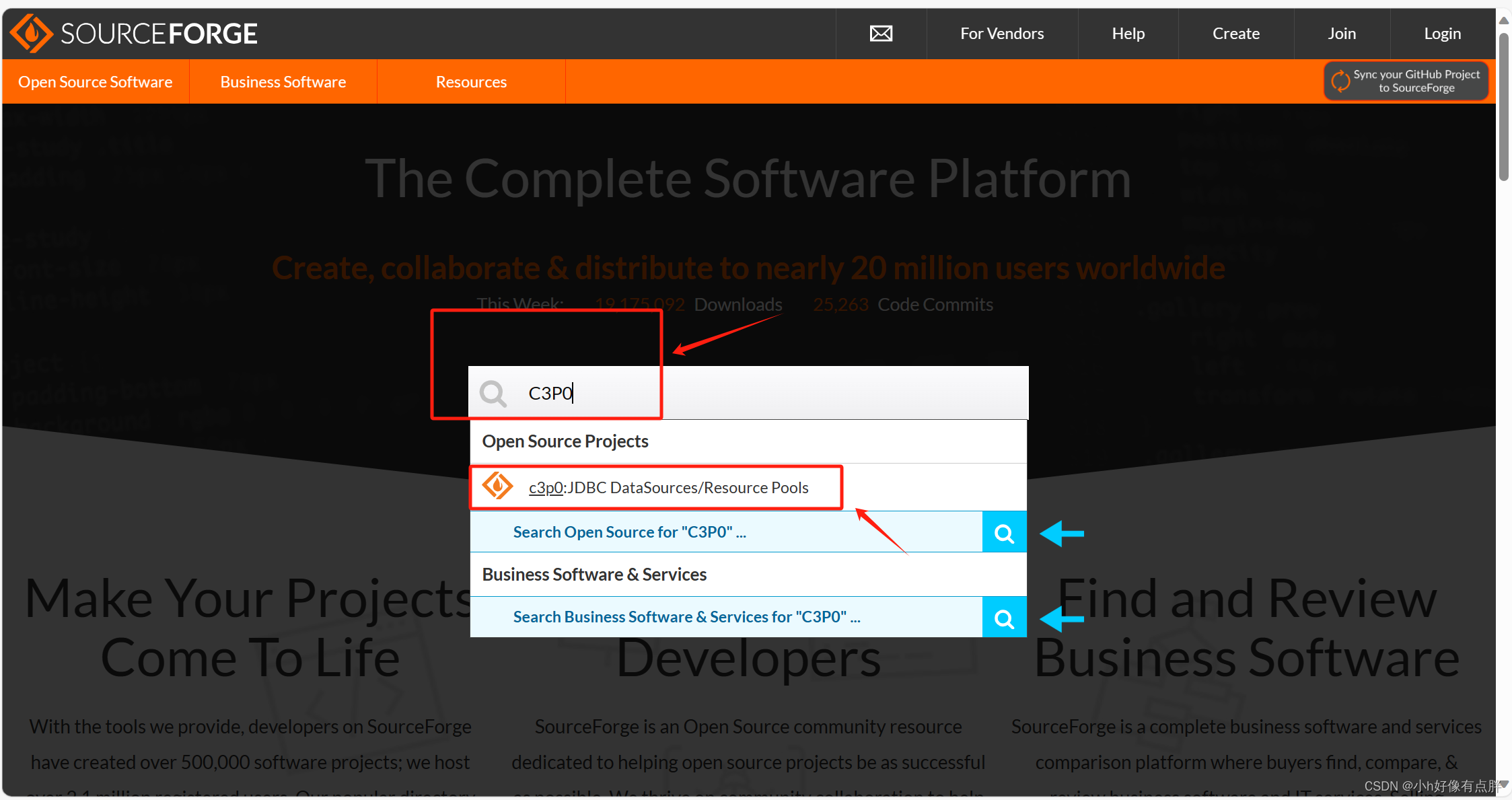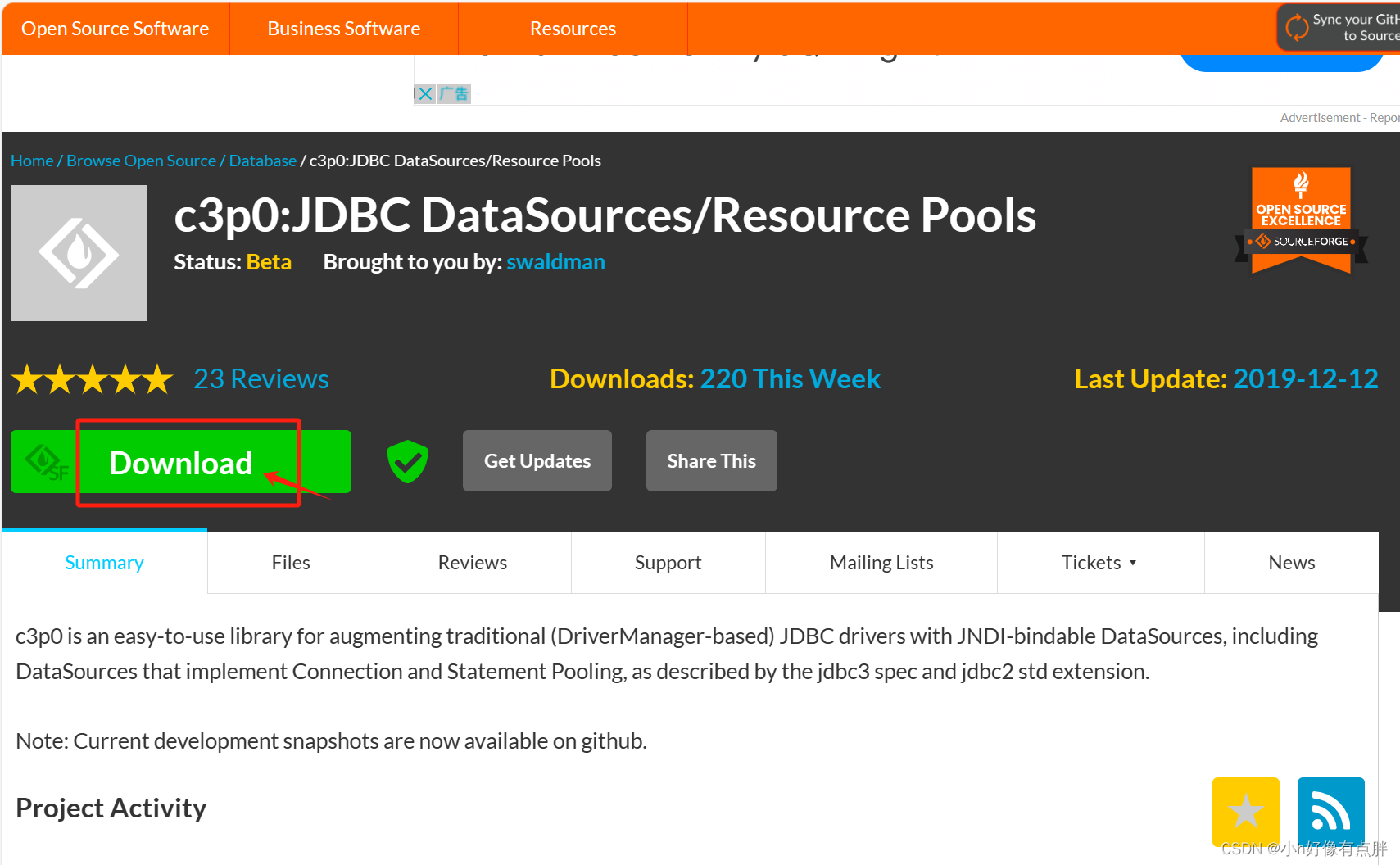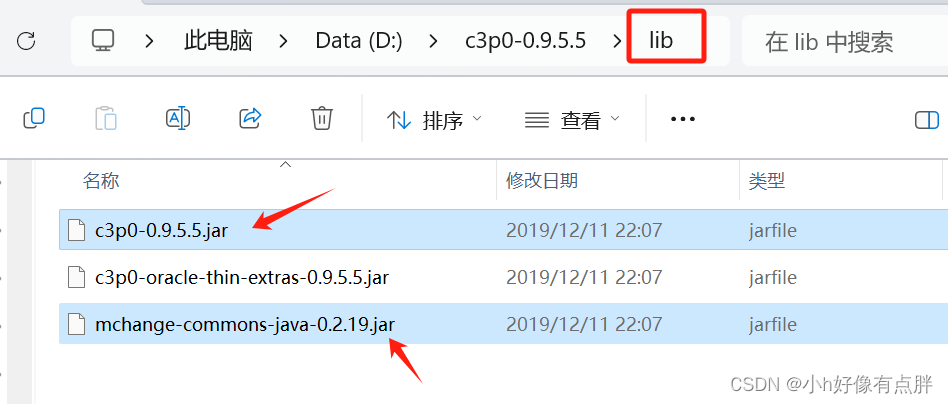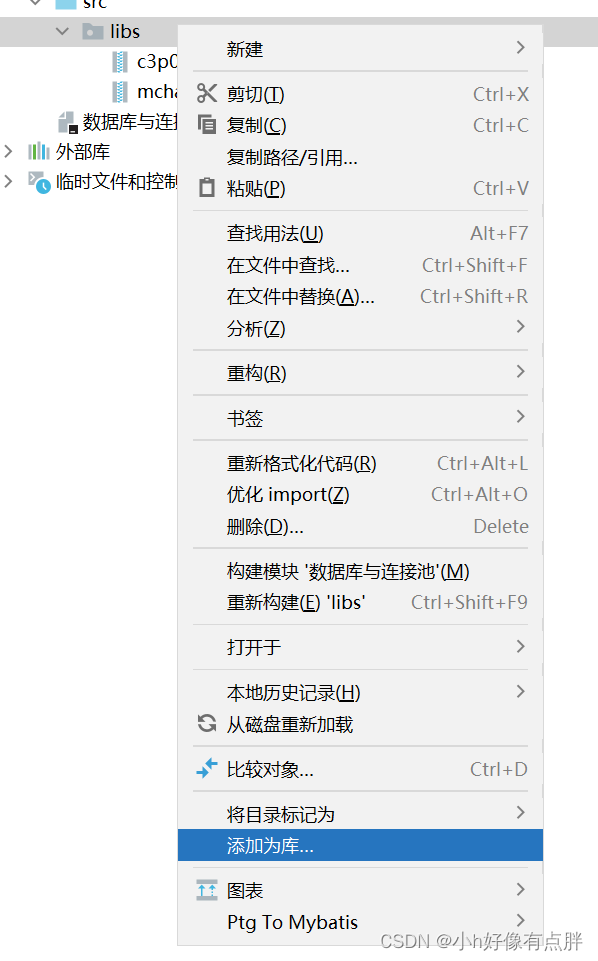JDBC
1.概念:
- 【 Java DataBase Connectivity 】,
Java数据库连接 - 即 ,JDBC的作用是:用Java语言操作数据库
2.本质:
官方定义的一套操作所有关系型数据库的规则/规范( 即接口-- API(Application Programming Interface ))
且由关系型数据库厂商自己写JDBC的实现类,实现这套接口(数据库驱动)
真正执行的代码是驱动jar包中的实现类
3.快速入门
步骤
导入驱动jar包
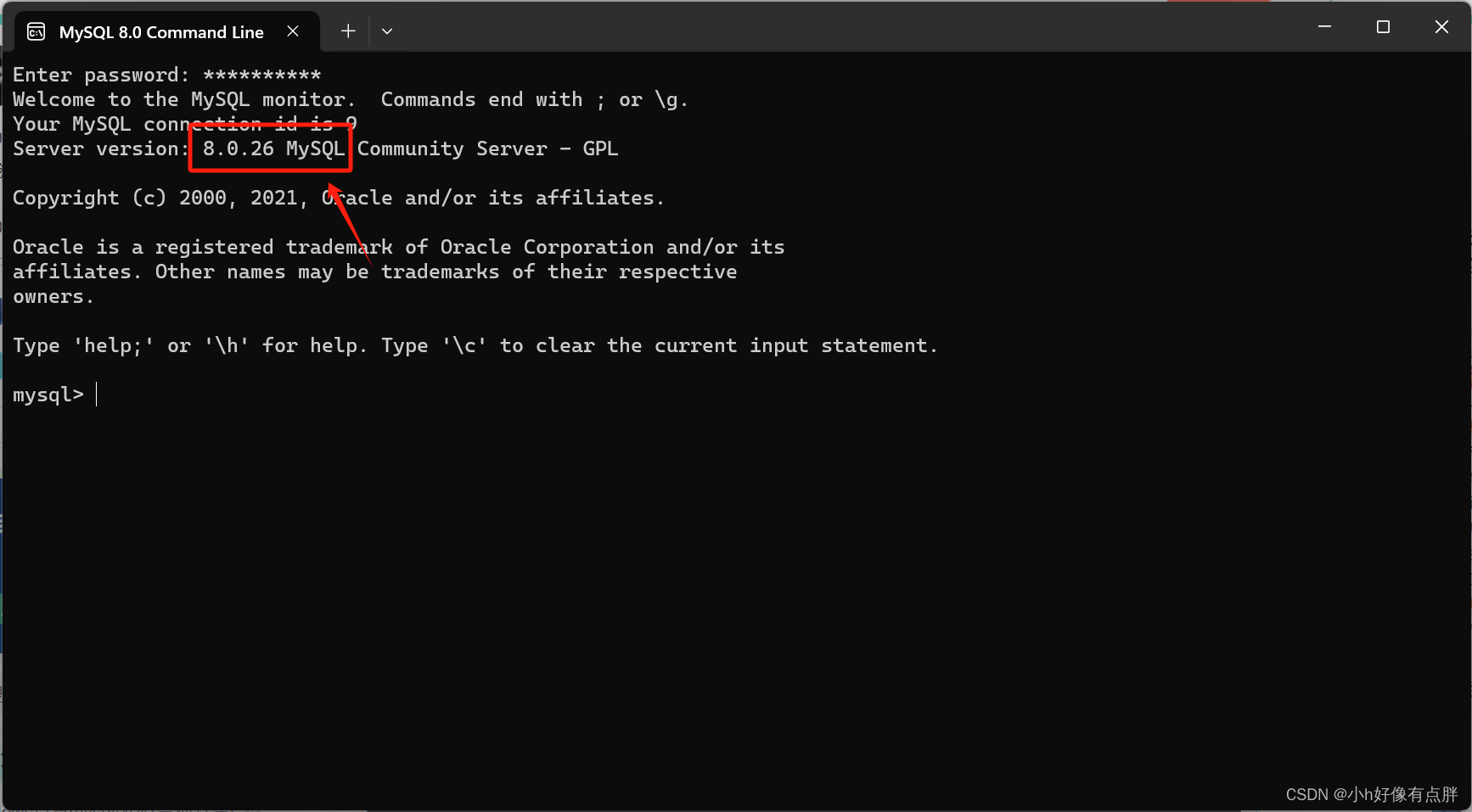
图1--查看MySQL版本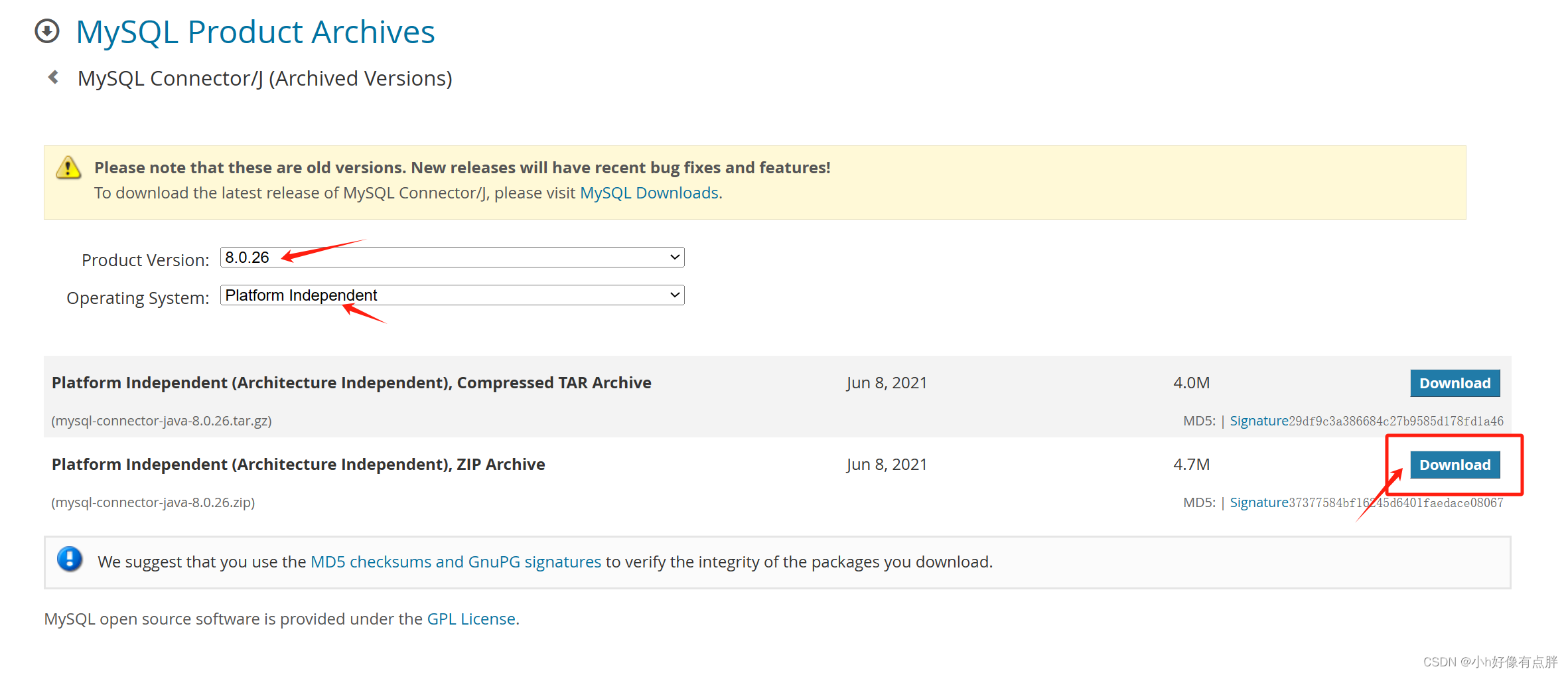
图2---到官网下载对应版本的jar包https://downloads.mysql.com/archives/c-j/ 是旧版本 页面有所不同
MySQL :: Download Connector/J 附上最新版下载地址
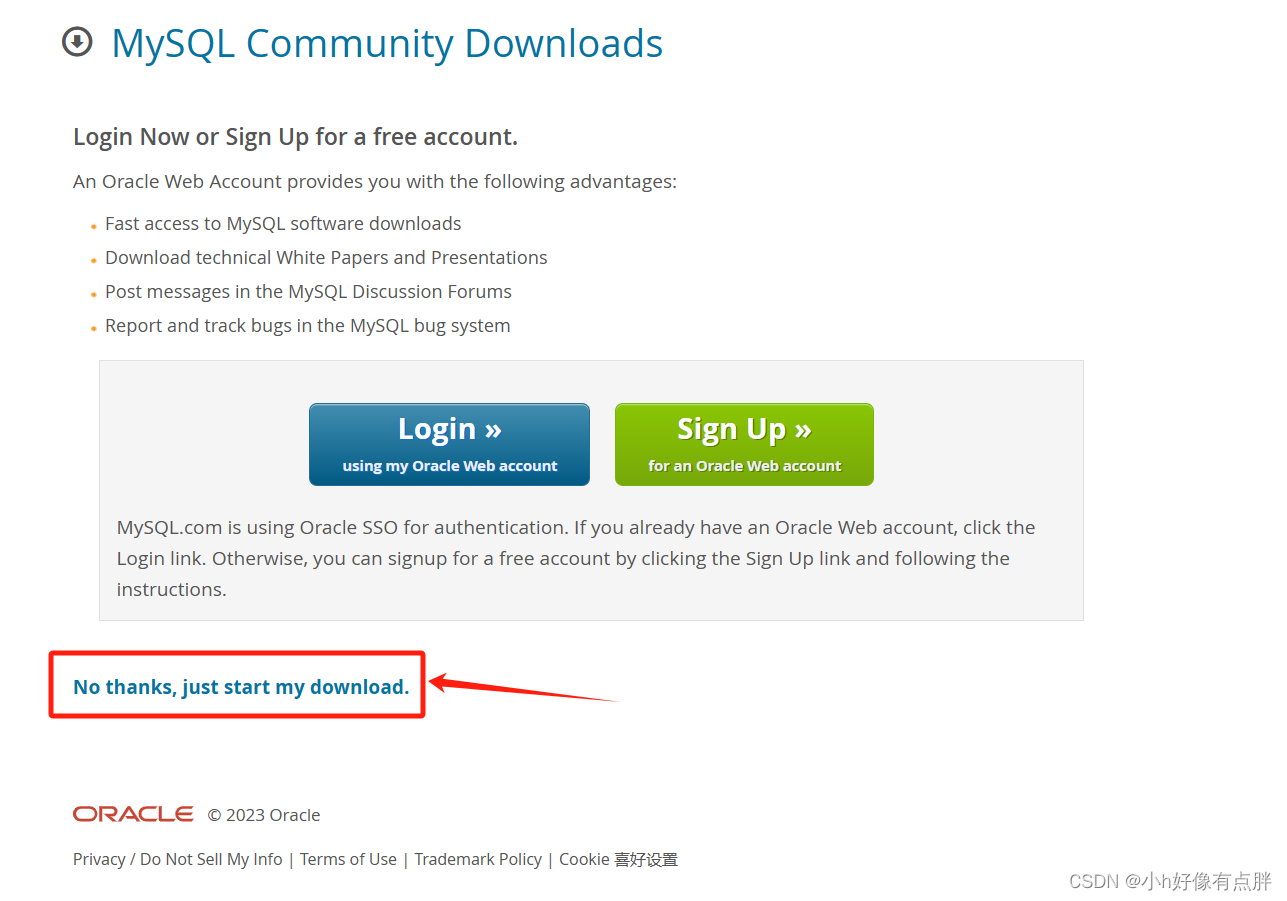
图3---直接下载无需登录注册Oracle官网账号在src中新建libs包
复制mysql-connector-java-8.0.26.jar 到项目libs目录下
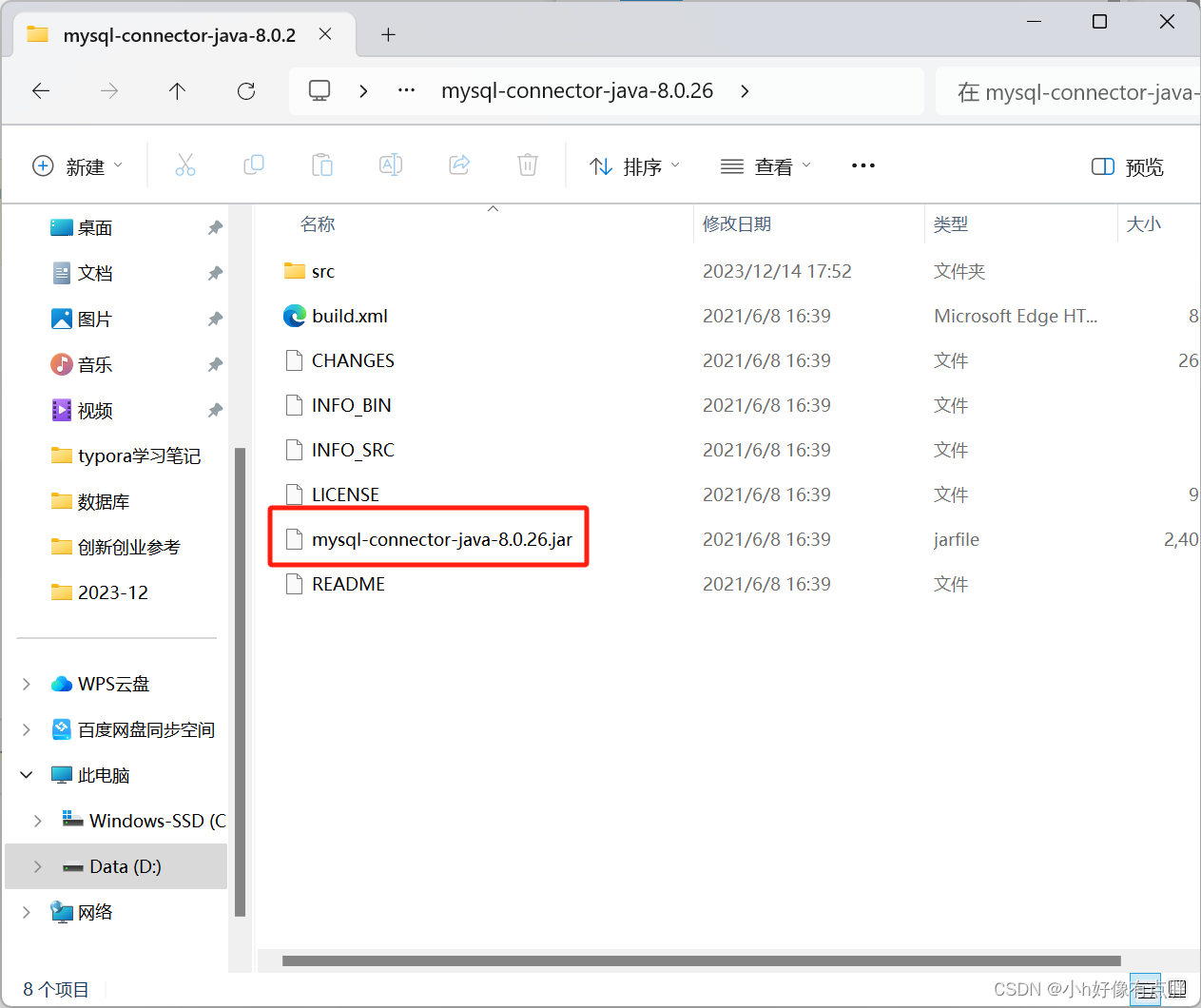
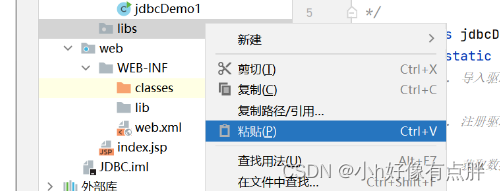
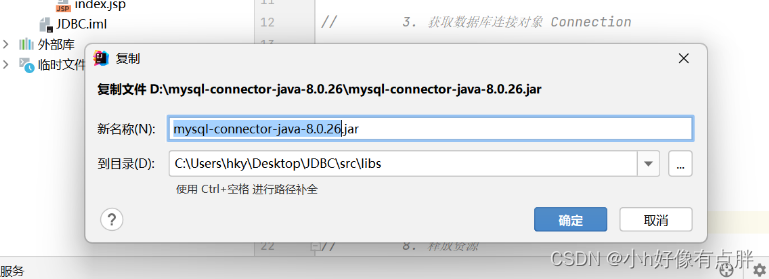
图4.图5.图6--复制jar包并粘贴右键—>add as library(添加为库)
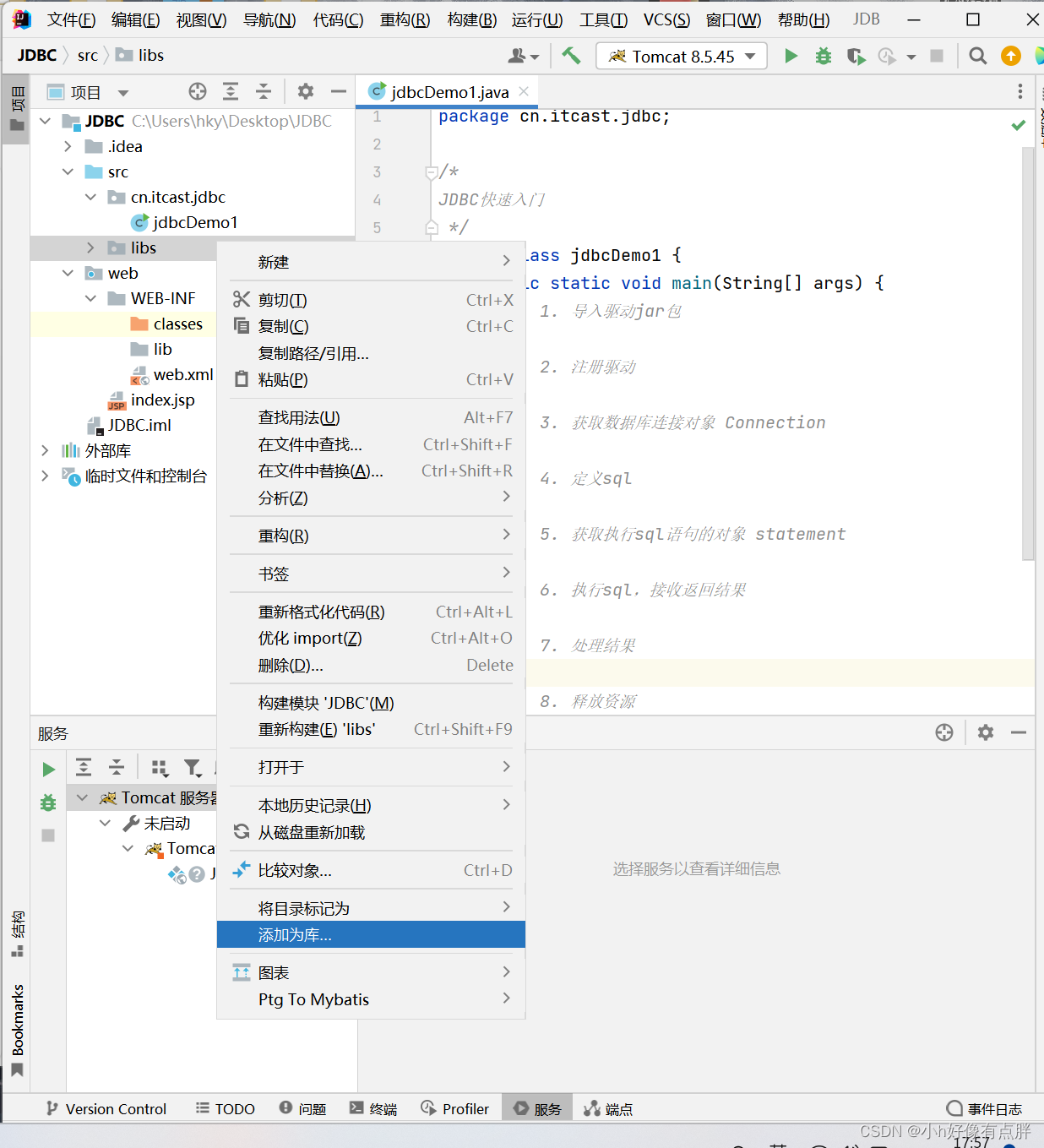
图7--添加为库
注册驱动
Class.forName("com.mysql.jdbc.Driver"); 


注:需要抛出异常(如图)
使用
throws Exception代替具体的异常类型(如throws ClassNotFoundException)
获取数据库连接对象 Connection
create database JDBC_study; use JDBC_study; create table account ( id int auto_increment primary key , name varchar(10) null, balance double null );
图8–提前准备的数据表
Connection connection=DriverManager.getConnection("jdbc:mysql://localhost:3306/JDBC_study"); //JDBC_study是我的数据库名 MySQL 8.0 以上版本的数据库连接:
com.mysql.jdbc.Driver更换为com.mysql.cj.jdbc.Driver
jdbc:mysql://localhost:3306/数据库名更换为jdbc:mysql://localhost:3306/数据库名?useSSL=false&allowPublicKeyRetrieval=true&serverTimezone=UTC
定义sql语句
String sql="update account set balance =500 where id=1";获取执行sql语句的对象 statement
Statement statement =connection.createStatement();执行sql,接收返回结果
int count=statement.executeUpdate(sql);处理结果
System.out.println(count);//释放资源
statement.close(); connection.close();
完整代码:
/* JDBC快速入门 */ public class jdbcDemo1 { public static void main(String[] args) throws Exception { // 1. 导入驱动jar包(已完成) // 2. 注册驱动 Class.forName("com.mysql.cj.jdbc.Driver");//可省略 // 3. 获取数据库连接对象 Connection //第二、三个参数是连接数据库的用户名和密码 Connection connection=DriverManager.getConnection("jdbc:mysql://localhost:3306/JDBC_study?useSSL=false&allowPublicKeyRetrieval=true&serverTimezone=UTC", "root", "Hky6600115"); // 4. 定义sql语句 String sql="update account set balance =500 where id=1"; // 5. 获取执行sql语句的对象 statement Statement statement =connection.createStatement(); // 6. 执行sql,接收返回结果 int count=statement.executeUpdate(sql); // 7. 处理结果 System.out.println(count); // 8. 释放资源 statement.close(); connection.close(); } }
运行检验:

图9--控制台输出(暂时不解读) 
图10--刷新数据库可见数据已修改 详解各对象
1️⃣.DriverManager 驱动管理对象
【一个类】
功能:
一、注册驱动:告诉程序应当使用哪一个数据库去驱动jar包
static void registerDriver(Driver driver)DriverManager 的方法上面快速入门的时候没有注册驱动 ,取而代之的是Class.forName(“com.mysql.jdbc.Driver”)也成功运行,原因如下:
查看
mysql.jdbc.Driver的源码可知//这是com.mysql.jdbc.Driver的静态代码块,只要使用这个类,就会执行这段代码 //而Class.forName("com.mysql.jdbc.Driver")就正好使用到了这个类 static { try { java.sql.DriverManager.registerDriver(new Driver()); } catch (SQLException E) { throw new RuntimeException("Can't register driver!"); } }因此,我们是通过给
forName指定了MySQL的驱动,它帮助我们注册驱动注意:MySQL5.0之后可以省略注册驱动的步骤
在jar包中,存在一个java.sql.Driver配置文件,文件中指定了com.mysql.jdbc.Driver
二、获取数据库连接
方法:
static Connection getConnection(String url, String user, String password);带三个参数参数:
url:指定连接的路径
语法:
jdbc:mysql://ip地址(域名):端口号/数据库名称【MySQL5.0写法】语法:
jdbc:mysql://ip地址(域名):端口号/JDBC_study?useSSL=false&allowPublicKeyRetrieval=true&serverTimezone=UTC【MySQL8.0写法】ip地址(域名)可以找到某一台计算机
端口号可以找到计算机上安装的MySQL服务器
细节:若连接的是本机mysql服务器,并且mysql服务默认端口是3306,则url可以简写为
jdbc:mysql:///数据库名称【MySQL5.0写法】,即省略ip地址(域名):端口号
user:用户名(本机常为root)
password:密码
2️⃣. Connection 数据库连接对象
功能:
一、获取执行sql的对象
- 获取普通执行者对象:
Statement createStatement(); - 获取预编译执行者对象:
PreparedStatement prepareStatement(String sql);
- 获取普通执行者对象:
二、管理事务
业务操作的多个步骤:要么同时成功,要么同时失败
数据库可以:开启/提交/回滚事务,针对此有以下三个对应方法:
- 开启事务:
setAutoCommit(boolean autoCommit);参数为false,则开启事务 - 提交事务:
commit(); - 回滚事务:
rollback();
- 开启事务:
3️⃣.statement 执行sql的对象⭐
功能:
执行sql对象
boolean execute(String sql);可以执行任意sql语句(了解即可)int executeUpdate(String sql);执行DML(insert、update、delete)语句以及DDL(create、alert、drop)返回值:影响的行数
eg. 前面运行过的,原先的表格经修改,id=1的balance由1000变成500,则这一行数据受到影响被改变返回值为1(见图9)
id name balance 1 zhangsan 1000---->500 2 lisi 1000 作用:可以通过这个影响的行数判断DML语句是否执行成功 返回值>0的则执行成功;反之,则失败
ResultSet executeQuery(String sql);执行DQL(select)
练习:基础
1.accunt表 添加一条记录
2.account表 修改记录
3.account表 删除一条记录
import java.sql.*; /* 1.accunt表 添加一条记录 */ public class jdbcDemo2 { public static void main(String[] args) throws Exception{ Statement statement=null; Connection connection=null; try { //1.注册驱动 Class.forName("com.mysql.cj.jdbc.Driver"); //2.定义sql String sql="insert into account values(null,'wangwu',3000)"; //3.获取connection对象 connection= DriverManager.getConnection("jdbc:mysql:///JDBC_study?useSSL=false&allowPublicKeyRetrieval=true&serverTimezone=UTC", "root", "Hky6600115"); //4.获取执行sql的对象statement statement=connection.createStatement(); //5.执行sql int count=statement.executeUpdate(sql);//影响行数【增加一行,应返回1】 //6.处理结果 System.out.println(count); if (count>0){ System.out.println("执行成功"); }else { System.out.println("执行失败"); } }catch (ClassNotFoundException e){ e.printStackTrace(); }catch (SQLException e){ e.printStackTrace(); /* 释放但因作用域问题报错-->因此提升作用域 statement.close(); connection.close(); */ }finally { //7.释放资源 //避免空指针异常 if(statement!=null){ try { statement.close(); }catch (SQLException e){ e.printStackTrace(); } } if(connection!=null){ try { connection.close(); }catch (SQLException e){ e.printStackTrace(); } } } } } 请仿造以上练习1的代码 ,完成练习2以及练习3
4️⃣.ResultSet 结果集对象
boolean next()- 如果有数据返回true,且光标向下移动一行
- 没有则返回false
XXX getXxx(列名/列编号)- XXX 表示数据类型 eg.int、String
- 例如:
int getInt(int)可以有int getInt(1)或者int getInt("id")
代码示例:
import java.sql.*; public class jdbcDemo5 { public static void main(String[] args) { Connection connection=null; Statement statement=null; ResultSet resultSet=null; try { Class.forName("com.mysql.cj.jdbc.Driver"); String sql="select * from account"; connection= DriverManager.getConnection("jdbc:mysql:///JDBC_study?useSSL=false&allowPublicKeyRetrieval=true&serverTimezone=UTC","root","Hky6600115"); statement=connection.createStatement(); resultSet= statement.executeQuery(sql); //处理结果 //1.让光标向下移动一行(默认在列名一行) resultSet.next(); //2.获取数据 int id=resultSet.getInt("id"); String name=resultSet.getString("name"); double balance=resultSet.getDouble("balance"); //3.打印数据 System.out.println(id+"---"+name+"---"+balance); } catch (ClassNotFoundException e) { e.printStackTrace(); } catch (SQLException e) { e.printStackTrace(); }finally { if(resultSet!=null){ try { resultSet.close(); } catch (SQLException e) { e.printStackTrace(); } } if(statement!=null){ try { statement.close(); } catch (SQLException e) { e.printStackTrace(); } } if(connection!=null){ try { connection.close(); } catch (SQLException e) { e.printStackTrace(); } } } } } 
图--运行结果 练习:遍历
案例代码:
其他步骤不变,仅改变数据处理过程
//处理结果(输出全部数据) //1.判断游标是否为最后一行末尾 while (resultSet.next()){ //2.获取数据 int id=resultSet.getInt("id"); String name=resultSet.getString("name"); double balance=resultSet.getDouble("balance"); //3.打印数据 System.out.println(id+"---"+name+"---"+balance); } 练习:封装对象
数据准备:
insert into emp VALUES (1001,'孙悟空',4,1004,'2000-12-17','8000.00',NULL,20), (1002,'卢俊义',3,1006,'2001-02-20','16000.00','3000.00',30), (100,'林冲',3,1006,'2001-02-22','12500.00','5000.00',30), (1004,'唐僧',2,1009,'2001-04-02','29750.00',NULL,20), (1005,'李逵',4,1006,'2001-09-28','12500.00','14000.00',30), (1006,'宋江',2,1009, '2001-05-01','28500.00',NULL,30), (1007,'刘备',2,1009,'2001-09-01','24500.00',NULL,10), (1008,'猪八戒',4,1004,'2007-04-19','30000.00',NULL,20), (1009,'罗贯中',1,NULL,'2001-11-17','50000.00',NULL,10), (1010,'吴用',3,1006,'2001-09-08','15000.00','0.00',30), (1011,'沙僧',4,1004,'2007-05-23','11000.00',NULL,20), (1012,'李逵',4,1006,'2001-12-03','9500.00',NULL,30), (1013,'小白龙',4,1004,'2001-12-03','30000.00',NULL,20), (1014,'关羽',4,1007,'2002-01-23','13000.00',NULL,10); 要求:定义一个方法,查询emp表中的数据并将其封装为对象,然后装载集合,返回
步骤:
- 定义emp类
- 定义方法 public List< EMP > findAll(){}
- 实现方法 select*from emp;
代码实现:
- 配置文件
jdbc.properties
url="jdbc:mysql:///JDBC_study?useSSL=false&allowPublicKeyRetrieval=true&serverTimezone=UTC" user=root password=Hky6600115' driver=com.mysql.cj.jdbc.Driver JDBCUtils工具类
public class JDBCUtils{ private static String url; private static String user; private static } 抽取JDBC工具类(JDBCUtils)
目的:简化书写
分析:
注册驱动
连接对象
需求:
传递参数❌(太麻烦)
保障工具类的通用性(MySQL5.0/MySQL8.0的url不同)
解决:配置文件
jdbc.properties【在src下创建】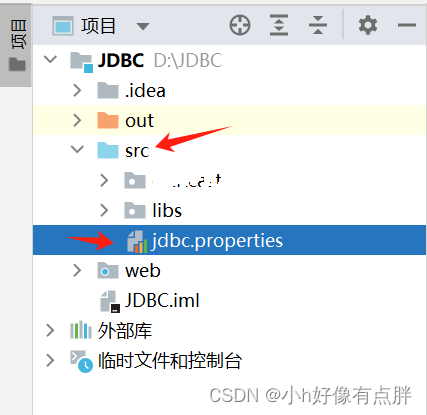
url=“”
user=“”
password=“”
driver=“”
实现代码:
import java.io.FileReader; import java.io.IOException; import java.net.URL; import java.sql.*; import java.util.Properties; /* JDBC工具类 */ public class JDBCUtils { /* 文件的读取只需要一次,便可以得到所有值 利用【静态代码块】 */ private static String url; private static String user; private static String password; private static String driver; static { //读取资源文件,获取值 try { //1.创建properties集合类 Properties properties=new Properties(); //获取src路径下的文件的方式--->classLoader 类加载器 ClassLoader classLoader = JDBCUtils.class.getClassLoader(); URL resource = classLoader.getResource("jdbc.properties"); String path = resource.getPath(); //System.out.println(path); //2.加载文件 // properties.load(new FileReader("jdbc.properties")); properties.load(new FileReader(path)); //3.获取数据,赋值 url=properties.getProperty("url"); user=properties.getProperty("user"); password=properties.getProperty("password"); driver=properties.getProperty("driver"); //4.注册驱动 Class.forName(driver); } catch (IOException e) { e.printStackTrace(); } catch (ClassNotFoundException e) { e.printStackTrace(); } } // 获取连接 public static Connection getConnection() throws SQLException { return DriverManager.getConnection(url, user, password); } // 释放资源 public static void close(ResultSet resultSet, Statement statement, Connection connection){ if(resultSet!=null){ try { resultSet.close(); } catch (SQLException e) { e.printStackTrace(); } } if(statement!=null){ try { statement.close(); } catch (SQLException e) { e.printStackTrace(); } } if(connection!=null){ try { connection.close(); } catch (SQLException e) { e.printStackTrace(); } } } public static void close(PreparedStatement preparedStatement, Connection connection) { if(preparedStatement!=null){ try { preparedStatement.close(); } catch (SQLException e) { e.printStackTrace(); } } if(connection!=null){ try { connection.close(); } catch (SQLException e) { e.printStackTrace(); } } } } 工具类练习
需求:
- 通过键盘录入用户名和密码
- 判断用户是否登录成功
- select * from user where username=““and password =””;
- 如果该sql语句有查询结果,则表示成功,反之则失败
步骤:
创建数据表user
create table user( id int primary key auto_increment, username varchar(32), password varchar(32) ); insert into user values (null,'zhangsan','123'); insert into user values (null,'lisi','234');编写登录方法
代码实现:
/* 登录方法 */ public boolean logion(String username,String password) { if(username==null||password==null){ return false; } //连接数据库判断是否登录成功 Connection connection=null; Statement statement=null; ResultSet resultSet=null; try { connection= JDBCUtils.getConnection(); String sql="select * from user where username='"+username+"'and password='"+password+"' "; statement=connection.createStatement(); resultSet=statement.executeQuery(sql); return resultSet.next(); } catch (SQLException e) { e.printStackTrace(); }finally { JDBCUtils.close(resultSet,statement,connection); } return false; } 5️⃣.PreparedStatement 执行sql的对象
sql注入问题:在拼接sql时,有一些sql的特殊关键字参与字符串的拼接,会造成安全性问题
以上面的练习为例
输入用户名:随机(eg.wangwu)
输入密码:a ’ or ’ a ’ = ’ a
- sql语句:select * from user where username =‘wangwu’ and password='a’or’a’=‘a’;
- 原sql语句:“select * from user where username='”+username+“‘and password=’”+password+"’ "
仔细对比观察
经典例子:
漫画中,该学生的姓名为“Robert’); DROP TABLE students;–”,导致students表被删除:
解决:使用PreparedStatement 对象
预编译sql:参数使用
?作为占用符步骤(稍复杂):
- 导入驱动jar包
- 注册驱动
- 获取数据库连接对象 connection
- 定义sql
- sql的参数使用
?作为占位符 - 如:
select * from user where username = ? and password = ?;
- sql的参数使用
- 获取执行sgl语句的对象 PreparedStatement
Connection.PreparedStatement (String sql)需要传参
- 给
?赋值:- 方法:
setXxx(参数1,参数2) - 参数1:
?的位置 - 参数2:
?的值
- 方法:
- 执行sql,接受返回结果 不需要传参
- 处理结果
- 释放资源
代码修改:
/* 登录方法,使用PreparedStatement 对象 */ public boolean logion(String username,String password) { if(username==null||password==null){ return false; } //连接数据库判断是否登录成功 Connection connection=null; ResultSet resultSet=null; PreparedStatement preparedStatement=null; try { connection= JDBCUtils.getConnection(); String sql="select * from user where username=?and password=?"; PreparedStatement=connection.preparedStatement(sql); preparedStatement.setString(1,username); preparedStatement.setString(2,password); resultSet=preparedStatement.executeQuery(); return resultSet.next(); } catch (SQLException e) { e.printStackTrace(); }finally { JDBCUtils.close(resultSet,preparedStatement,connection); } return false; } - 注意:后期改用 preparedStatement 来完成增删改查的操作
- 优势:
- 防止sql注入
- 效率更高
- 优势:
JDBC控制事务
事务 :一个包含多个步骤的业务操作。如果这个业务操作被事务管理,则这多个步骤要么同时成功,要么同时失败。
操作:
- 开启事务
- 提交事务
- 回滚事务
使用connection对象来管理事务
- 开启事务
setAutoCommit(boolean autoCommit): 调用该方法设置参数为 false,即开启事务- 在执行sql之前开启事务
- 提交事务
commit()- 当所有sql都执行完提交事务
- 回滚事务
rollback()- 在catch中回滚事务
- 开启事务
练习:转账
代码实现:
import cn.itcast.util.JDBCUtils; import java.sql.*; /* 事务操作 */ public class jdbcDemo10 { /* 转账方法 */ public static void main(String[] args) throws Exception { Connection connection=null; PreparedStatement preparedStatement1=null; PreparedStatement preparedStatement2=null; ResultSet resultSet=null; try { //1.获取连接 connection= JDBCUtils.getConnection(); // 开启事务 connection.setAutoCommit(false); //2.定义sql //2.1. 张三-500 //2.2. 李四+500 String sql1="update account set balance = balance - ? where id = ?"; String sql2="update account set balance = balance + ? where id = ?"; //3.获取执行对象 preparedStatement1=connection.prepareStatement(sql1); preparedStatement2=connection.prepareStatement(sql2); //4.设置参数 preparedStatement1.setDouble(1,500); preparedStatement1.setInt(2,1); preparedStatement2.setDouble(1,500); preparedStatement2.setInt(2,2); //5.执行sql preparedStatement1.executeUpdate(); preparedStatement2.executeUpdate(); // 提交事务 connection.commit(); } catch (Exception e) { // 事务回滚 try { if(connection!=null){ connection.rollback(); } }catch (SQLException e1){ e1.printStackTrace(); } e.printStackTrace(); }finally { JDBCUtils.close(preparedStatement1,connection); JDBCUtils.close(preparedStatement2,null); } } } 数据库与连接池
1. 概念:
存放数据库连接的一个容器(集合)Connection
当系统运行起来之后,这个连接池就被创建,在这个连接池当中,会申请一些对象,当有用户来访问数据库的时候,就从这个连接池当中获取连接对象,用户访问结束之后,连接池对象会归还给容器
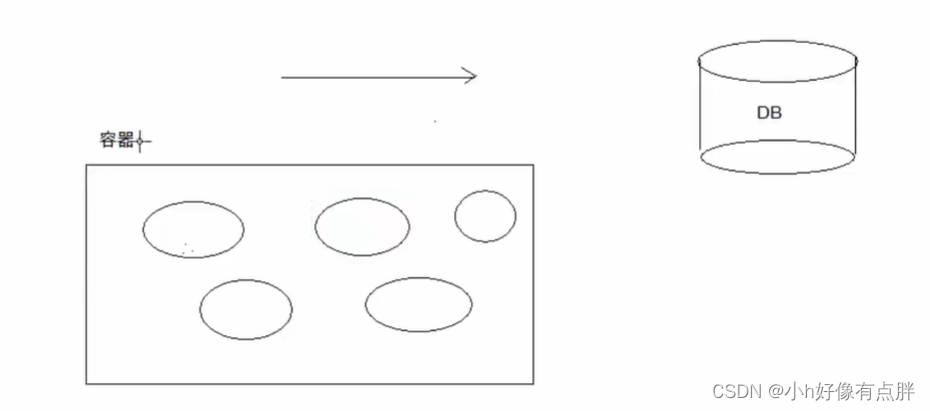
2.优点:
- 节约资源
- 用户访问高效
3. 连接池实现:
- java官方提供的数据库连接池规范(接口):
DataSource(javax.sql包下)- 方法:【获取连接:
getConnection();】 - 【归还连接池对象:
conn.close();】
- 方法:【获取连接:
- 由数据库厂商为我们实现该接口
- C3P0
- Druid (阿里巴巴开发)
4.C3P0
步骤:
1. 导入jar包
官网:https://sourceforge.net/
进入官网,搜索框中输入c3p0,并点击下面的提示
点击下载即可
解压后,在lib文件夹中,复制如下两个jar包到项目lib文件夹中(还有不能忘记数据库驱动jar包mysql-connector-java-8.0.26.jar)
右键libs添加为库
2. 定义配置文件:
- 文件命名为:
c3p0.properties或者c3p0-config.xml - 位置:src目录下
- 1.自定义的
c3p0-config.xml
<c3p0-config> <!-- 使用默认的配置读取连接池对象 --> <default-config> <!-- 连接参数 --> <property name="driverClass">com.mysql.cj.jdbc.Driver</property> <property name="jdbcUrl">jdbc:mysql://localhost:3306/jdbc_study</property> <property name="user">root</property> <property name="password">Hky6600115</property> <!-- 连接池参数 --> <property name="initialPoolSize">5</property> <property name="maxPoolSize">10</property> <property name="checkoutTimeout">3000</property> </default-config> <named-config name="otherc3p0"> <!-- 连接参数 --> <property name="driverClass">com.mysql.jdbc.Driver</property> <property name="jdbcUrl">jdbc:mysql://localhost:3306/day25</property> <property name="user">root</property> <property name="password">root</property> <!-- 连接池参数 --> <property name="initialPoolSize">5</property> <property name="maxPoolSize">8</property> <property name="checkoutTimeout">1000</property> </named-config> </c3p0-config> - 2.参数解释
- initialPoolSize:初始化申请的连接数量
- maxPoolSize:最大的连接数量
- checkoutTimeout:超时时间
3. 创建核心对象
数据库连接池对象 ComboPooledDataSource
4. 获取连接
getConnection
代码实现:
import com.mchange.v2.c3p0.ComboPooledDataSource; import javax.sql.DataSource; import java.sql.Connection; /* c3p0的演示 */ public class c3p0Demo1 { public static void main(String[] args) throws Exception { //1.创建数据库连接池对象 DataSource dataSource=new ComboPooledDataSource(); //2.获取连接对象 Connection connection = dataSource.getConnection(); //3.打印 System.out.println(connection); } } 参数检验:
5
10
3000
1. 检验最大连接数量
public class c3p0Demo2 { public static void main(String[] args) throws Exception { DataSource dataSource=new ComboPooledDataSource(); for (int i=1;i<=10;i++){ Connection connection=dataSource.getConnection(); System.out.println(i+":"+connection); } } } 运行结果:(正常)

2. 检验超时时间
–> 运行有错误会等带一段时间再报错
for (int i=1;i<=11;i++){ Connection connection=dataSource.getConnection(); System.out.println(i+":"+connection); } 运行结果:(先输出正常部分,隔3秒报错)
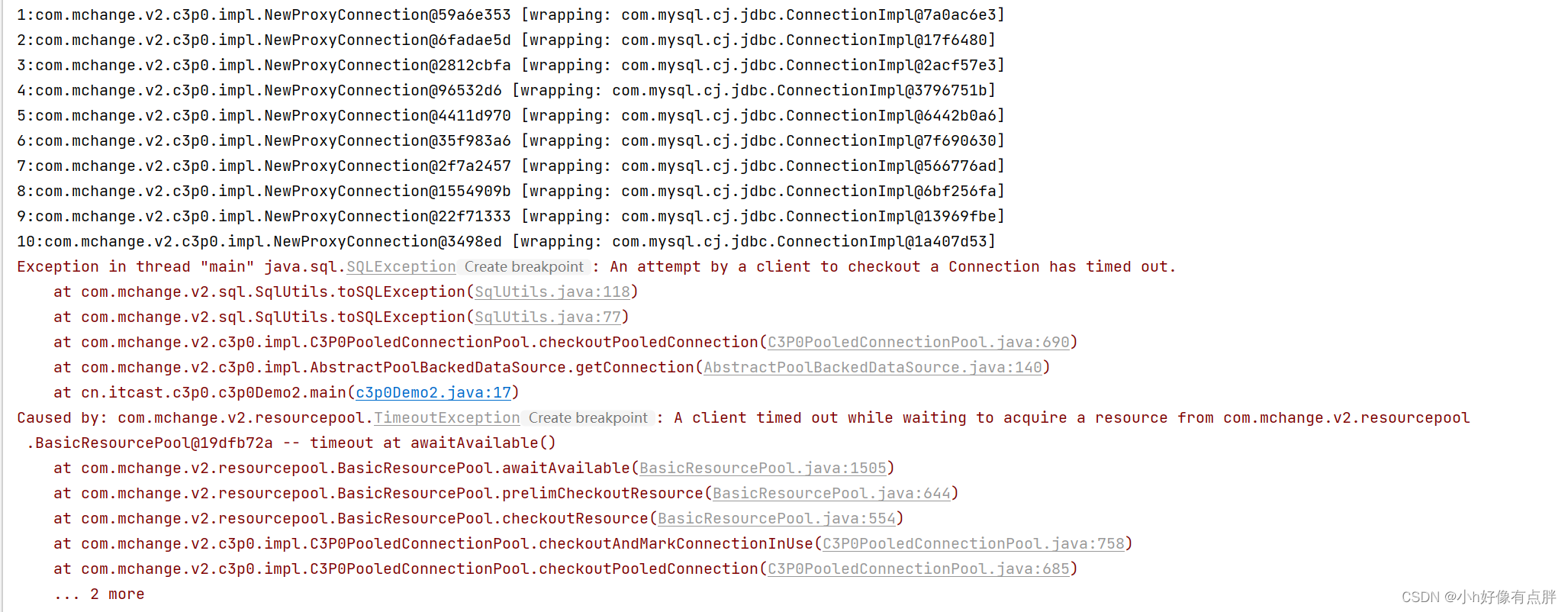
若中途归还对象,即可正常(重复使用)
public static void main(String[] args) throws SQLException { DataSource dataSource=new ComboPooledDataSource(); for (int i=1;i<=11;i++){ Connection connection=dataSource.getConnection(); System.out.println(i+":"+connection); if(i==5){ connection.close(); } } } 注:
DataSource dataSource=new ComboPooledDataSource();表示使用默认配置DataSource dataSource=new ComboPooledDataSource("otherc3p0");表示使用指定名称配置
5.Druid
步骤:
1. 导入jar包
官网下载地址:Central Repository: com/alibaba/druid (maven.org)

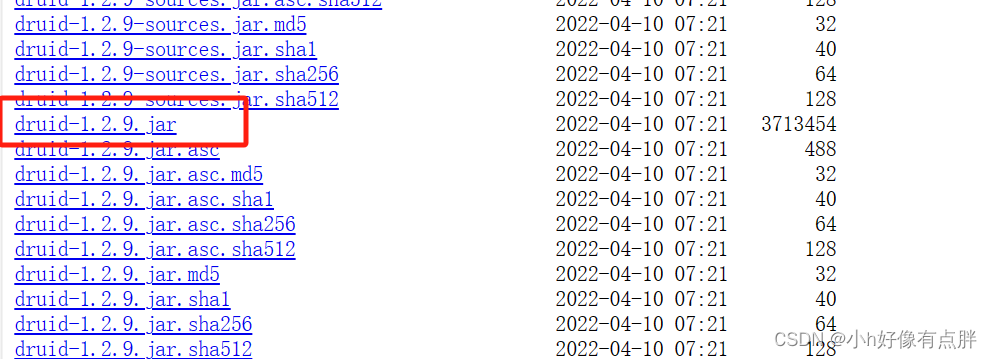
(详见c3p0)
2.定义配置文件
- 是properties形式的
- 可以叫任意名称,可以放在任意目录下
- 不会自动加载,需要手动
//示例 druid.properties driverClassName=com.mysql.cj.jdbc.Driver url=jdbc:mysql:///JDBC_study?useSSL=false&allowPublicKeyRetrieval=true&serverTimezone=UTC username=root password=password # 初始化连接数量 initialSize=5 #最大连接数 maxActive=10 # 最大等待时间 maxWait=3000 步骤+1:加载配置文件
3. 获取数据库连接池对象
通过工厂类来获取 DruidDataSourceFactory
4. 获取连接
getConnection
代码实现:
import com.alibaba.druid.pool.DruidDataSourceFactory; import javax.sql.DataSource; import java.io.InputStream; import java.sql.Connection; import java.util.Properties; public class DruidDemo { public static void main(String[] args) throws Exception { //加载配置文件 Properties properties=new Properties(); InputStream inputStream=DruidDemo.class.getClassLoader().getResourceAsStream("druid.properties"); properties.load(inputStream); //获取连接池对象 DataSource dataSource =DruidDataSourceFactory.createDataSource(properties); //获取连接 Connection connection=dataSource.getConnection(); System.out.println(connection); } } 定义工具类
1. 定义一个类
2. 静态代码块
- 提供静态代码块加载配置文件,初始化连接池对象
3. 提供方法
- 获取连接方法;通过数据库连接池获取连接
- 释放资源
- 获取连接池的方法
代码实现:
import com.alibaba.druid.pool.DruidDataSourceFactory; import javax.sql.DataSource; import java.io.IOException; import java.sql.Connection; import java.sql.ResultSet; import java.sql.SQLException; import java.sql.Statement; import java.util.Properties; /* Druid连接池工具类 */ public class JDBCUtils { private static DataSource dataSource; static { try { Properties properties=new Properties(); properties.load(JDBCUtils.class.getClassLoader().getResourceAsStream("druid.properties")); dataSource= DruidDataSourceFactory.createDataSource(properties); } catch (IOException e) { e.printStackTrace(); } catch (Exception e) { e.printStackTrace(); } } /* 获取连接的方法 */ public static Connection getConnection() throws SQLException { return dataSource.getConnection(); } /* 释放资源 */ public static void close(ResultSet resultSet,Statement statement, Connection connection){ if (resultSet!=null){ try { resultSet.close(); } catch (SQLException e) { e.printStackTrace(); } } if (statement!=null){ try { statement.close(); } catch (SQLException e) { e.printStackTrace(); } } if (connection!=null){ try { connection.close();//归还连接 } catch (SQLException e) { e.printStackTrace(); } } } public static void close(Statement statement, Connection connection){ close(null,statement,connection); } /* 获取连接池 */ public static DataSource getDataSource(){ return dataSource; } } JDBCTemplate
Spring框架对JDBC的简单封装,提供了一个JdbcTemplate对象,大大的简化了开发
步骤
1. 导入jar包
以下是我的下载参考页面地址↓
spring jar包 以及 jdbcTemplate 相关jar包下载_jdbctemplate的jar包-CSDN博客
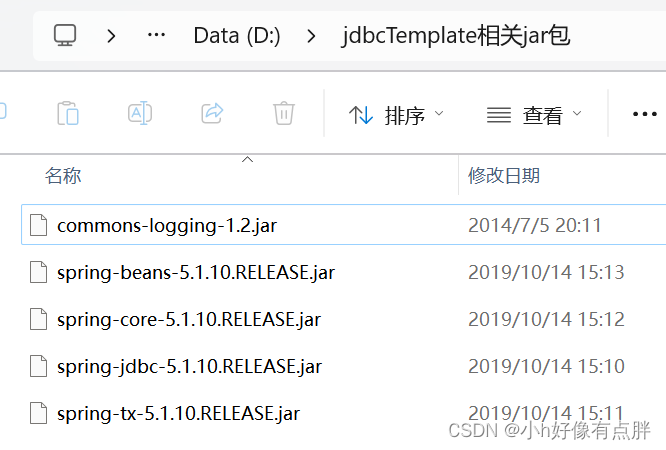
2.创建JdbcTemplate对象
- 依赖于数据源DataSource
JdbcTemplate template = new jdbcTemplate(dataSource);
import cn.itcast.JDBC数据库与连接池.datasource.utils.JDBCUtils; import org.springframework.jdbc.core.JdbcTemplate; /* JDBCTemplateDemo1 入门 */ public class JDBCTemplateDemo1 { public static void main(String[] args) { // 1.导入jar包 // 2.创建JDBCTemplate JdbcTemplate template=new JdbcTemplate(JDBCUtils.getDataSource()); // 3.调用方法 String sql="update account set balance=5000 where id=?"; int count =template.update(sql,2); System.out.println(count); } } 3. 调用JdbcTemplate的方法来完成CRUD的操作
update():执行DML语句。增、删、改语句queryForMap():查询结果将结果集封装为map集合queryForList():查询结果将结果集封装为list集合query():查询结果,将结果封装为JavaBean对象queryForobject:查询结果,将结果封装为对象
4. 练习
- 修改1号数据的 salary 为 10000
- 添加一条记录
- 删除刚才添加的记录
- 查询id为1的记录,将其封装为Map集合
- 查询所有记录,将其封装为List
- 查询所有记录,将其封装为Emp对象的List集合
- 查询总记录数


